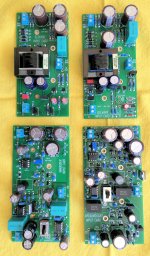Yes - the paper says 10w @8ohm speakers, and 5w @4ohm, and recommends speakers =>90db
With the success of the ACA, I was wondering when SMPS (filtered) was going to enter the mainstream here.
With the success of the ACA, I was wondering when SMPS (filtered) was going to enter the mainstream here.
Out of curiosity, how does this differ from previous "DIY Sony VET" designs and docs from 5 years ago?
Major difference is only two the same polarities Sony Vfets 2 pcs. = stereo amplifier.
Previous ones was push-pull so two or more Vfets N P pairs 4 pcs.= stereo amplifier
Are there any benefits to matching the 2 Sony VFETs in this design? I'm guessing it's not necessary based on what I read in the doc, but it does say that transistor matching "is nice".
Either way, I'd imagine matching VFETs for the kits would be... quite tedious. lol
Either way, I'd imagine matching VFETs for the kits would be... quite tedious. lol
Yes, thanks again to the ever generous Nelson Pass - this post will take off and be long lived as all the offerings become available over time.
As mentioned in the last paragraph on page 2 of Nelson's .pdf document, attached to post #1 in this thread, there are four more "front end" cards for this amplifier. These are shown in the photo below.
Clockwise from top left, the cards are named Scourge, Bulwark, Dreadnought, and Marauder. Thread viewers who are familiar with British warships of the last 100 years, may recognize some of those names.
Two of these front end cards include Edcor PC600-15K interstage transformers, and two of them do not. All of them include large polypropylene input coupling capacitors, easily seen as large rectangles in either teal color (KEMET F461 capacitors) or black (Panasonic ECWFE capacitors).
I'll provide more details, discussion, schematics, and photos in a couple days. For now, simply treat this photo as potential evidence that the other 4 front end cards which Nelson talked about, actually do exist today.
Click on the thumbnail image, and then click again on the white "X" cross at bottom left, to see everything at full magnification.
_
_
Clockwise from top left, the cards are named Scourge, Bulwark, Dreadnought, and Marauder. Thread viewers who are familiar with British warships of the last 100 years, may recognize some of those names.
Two of these front end cards include Edcor PC600-15K interstage transformers, and two of them do not. All of them include large polypropylene input coupling capacitors, easily seen as large rectangles in either teal color (KEMET F461 capacitors) or black (Panasonic ECWFE capacitors).
I'll provide more details, discussion, schematics, and photos in a couple days. For now, simply treat this photo as potential evidence that the other 4 front end cards which Nelson talked about, actually do exist today.
Click on the thumbnail image, and then click again on the white "X" cross at bottom left, to see everything at full magnification.
_
_
Attachments
Last edited:
Oh man, I’m intrigued by those switches!
*edit* now I see. Easy phase inversion. Nice!
*edit* now I see. Easy phase inversion. Nice!
Last edited:
4x times more fun! Thanks Mark. And of course thanks to Nelson to his continued generosity to us lucky few.
Question for Mark/Nelson: because of the limited number of kits available, will the various front end cards be applicable to other SIT designs beside the imminent release for Sony Vfets? My impression is yes, but I'd like Mark's verification and comment. Thanks. - David
Question for Mark/Nelson: because of the limited number of kits available, will the various front end cards be applicable to other SIT designs beside the imminent release for Sony Vfets? My impression is yes, but I'd like Mark's verification and comment. Thanks. - David
anybody thinking of using one channel - N VFet follower and other channel - P VFet follower?

In parallel to make one channel maybe??
There is no particular benefit apart from relief of audiophile nervosa, but since I had tested all the vfets and sorted them by Vgs, it was trivial to match them. You can see the number on the parts.


In parallel to make one channel maybe??
That's a thought - cancellation of second harmonic and/or driving 4 ohm loads.
However, the N ch version has gnd and minus supply.
- Home
- Amplifiers
- Pass Labs
- DIY Sony VFET pt 1





